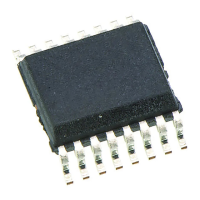RL78/G10 CHAPTER 6 TIMER ARRAY UNIT
R01UH0384EJ0311 Rev. 3.11 136
Dec 22, 2016
6.4 Basic Rules of Timer Array Unit
6.4.1 Basic rules of simultaneous channel operation function
When simultaneously using multiple channels, namely, a combination of a master channel (a reference timer mainly
counting the cycle) and slave channels (timers operating according to the master channel), the following rules apply.
(1) Only an even channel (channel 0, 2) can be set as a master channel.
(2) Any channel, except channel 0, can be set as a slave channel
Note
.
(3) The slave channel must be lower than the master channel.
Example: If channel 2 is set as a master channel, channel 3 can be set as a slave channel.
(4) Two or more slave channels can be set for one master channel.
(5) When two or more master channels are to be used, slave channels with a master channel between them may not
be set.
Example: If channels 0 and 2 are set as the master channel, only channel 1 can be set as the slave channel of
master channel 0. Channel 3 cannot be set as the slave channel of master channel 0.
(6) The operating clock for a slave channel in combination with a master channel must be the same as that of the
master channel. The CKS0n1 bit (bit 7 of timer mode register 0nH (TMR0nH)) of the slave channel that operates
in combination with the master channel must be the same value as that of the master channel.
(7) A master channel can transmit the interrupt request signal (INTTM0n), start software trigger, and count clock (f
TCLK)
to the lower channels.
(8) A slave channel can use the interrupt request signal (INTTM0n), a start software trigger, or the count clock (f
TCLK)
of the master channel as a source clock, but cannot transmit its own INTTM0n, start software trigger, or count
clock (f
TCLK) to channels with lower channel numbers.
(9) A master channel cannot use the interrupt request signal (INTTM0n), a start software trigger, or the count clock
(f
TCLK) from the other higher master channel as a source clock.
(10) To simultaneously start channels that operate in combination, the channel start trigger bit (TS0n) of the channels in
combination must be set at the same time.
(11) During the counting operation, a TS0n bit of a master channel or TS0n bits of all channels which are operating
simultaneously can be set. It cannot be applied to TS0n bits of slave channels alone.
(12) To stop the channels in combination simultaneously, the channel stop trigger bit (TT0n) of the channels in
combination must be set at the same time.
Note When channel 1 or 3 is used as an 8-bit timer, the lower 8 bits can be selected as the slave channel that
operates in combination. In this case, the higher 8 bits of channel 1 or 3 can be used as an interval timer.
Remark n: Channel number
n = 0, 1 (for 10-pin products); n = 0 to 3 (for 16-pin products)
The rules of the simultaneous channel operation function are applied in a channel group (a master channel and slave
channels forming one simultaneous channel operation function).
If two or more channel groups that do not operate in combination are specified, the basic rules of the simultaneous
channel operation function in 6.4.1 Basic rules of simultaneous channel operation function do not apply to the
channel groups.

